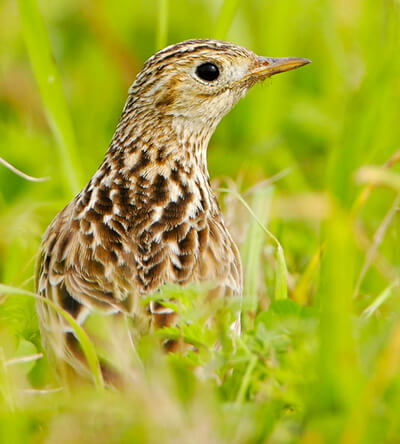First-ever Report Shows Dramatic Changes in Canada's Bird Populations
 |
| Sprague's Pipit by Greg Lavaty |
(July 6, 2012) The first national report on the state of Canada's birds finds that, since 1970, the nation's bird population has dropped by 12 percent and that some groups of birds have decreased by more than 40 percent and some species by more than 90 percent. A similar report is produced every year by the U.S. Fish and Wildlife Service, with input from American Bird Conservancy and over 20 other organizations, titled “State of the Birds,” which covers the United States.
The State of Canada's Birds report looked at 40 years of data and summarizes the status of
Canada's bird populations for eight regions, including the boreal forest, prairies, Arctic, and
oceans. The scientific report also identifies the most significant conservation opportunities for
Canadians to ensure healthy bird populations and healthy ecosystems.
The report finds that overall, more species are decreasing (44% of species in Canada) than increasing (33%). The groups that have severely declined include grassland birds, migratory shorebirds, and aerial insectivores (birds that catch insects in flight). These groups have all decreased by more than 40%, on average, with some individual species suffering declines of more than 90%. Other species have increased as a result of successful conservation efforts. The ban on pesticides in the 1970s has helped recover raptors such as the Peregrine Falcon, Osprey, and Bald Eagle. Effective management of wetlands and hunting has aided waterfowl (ducks and geese).
Canada is home to 451 regularly occurring, native species that raise their young or spend their non-breeding seasons there. Nationally, there are 66 bird species currently assessed as Endangered, Threatened, or of Special Concern. Many of these species also occur in the United States or pass through on their migration, making this report relevant for U.S. bird conservation.
The report is considered significant since the health of bird populations is widely seen as an indicator of broader ecosystem health. Changes in bird populations reflect changes in ecosystems that provide vital human needs such as food, clean air, and water.
The State of Canada's Birds report is a collaborative effort of the North American Bird Conservation Initiative in Canada (NABCI-Canada), whose members include federal, territorial and provincial governments, non-government conservation organizations (NGOs), and private sector organizations.
State of Canada's Birds is available online at stateofcanadasbirds.org.
Additional highlights from the report include:
- Grassland birds, including longspurs, meadowlarks, Sprague's pipit, Greater Sage-Grouse,
and others, are in decline due largely to a loss of habitat. - Aerial insectivores – swallows, flycatchers and other birds that catch insects in flight –
are declining more steeply than any other group of birds, but the causes of the decline are
unknown. - Shorebirds have declined by almost half overall, while Arctic shorebirds in particular,
including the Red Knot, have declined by 60%. - Increasing raptor populations, such as the Peregrine Falcon, point to the success of direct
conservation actions, including pesticide controls.
The report cites a plethora of causes for the declines, including: draining of wetlands; clearing of forests; conversion of native grasslands to crop lands; replacement of natural habitats with urban and industrial developments; the introduction and spread of invasive species and the release of industrial chemicals and pesticides into the air and water. The Passenger Pigeon, Great Auk, and Labrador Duck are bird species that disappeared forever as a result of such activities.


















































